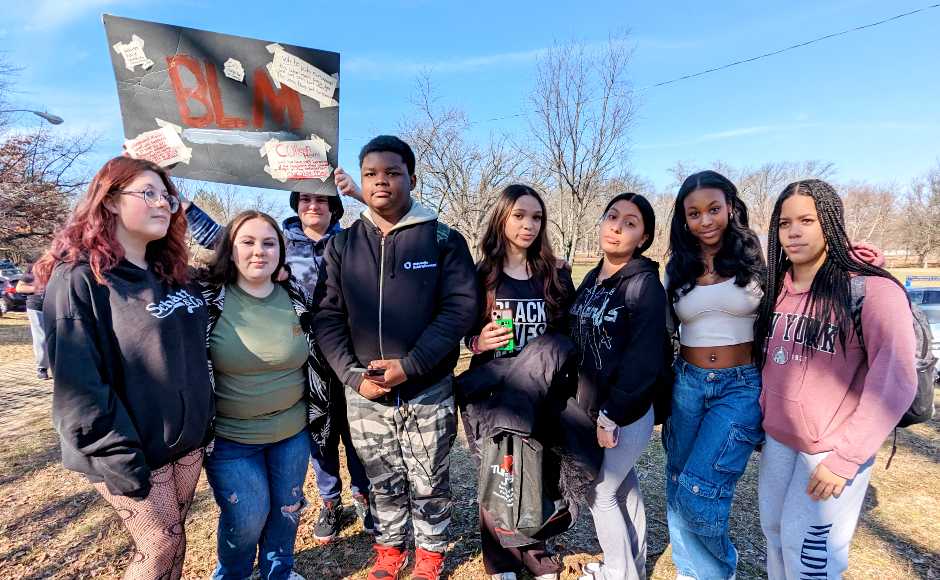Reports from current and former CHS students paint a picture of a school divided, in which white students casually and regularly direct slurs at their Black classmates with impunity.
By Matt Skoufalos | April 11, 2024
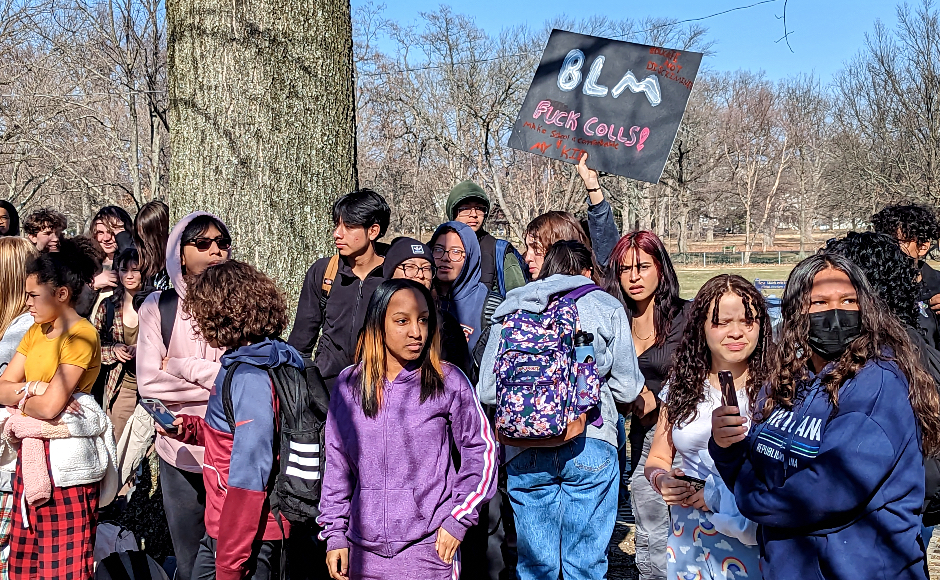
In February 2023, Collingswood High School students protested what they described as a climate of bias in the district. Credit: Matt Skoufalos.
Last year, students at Collingswood High School (CHS) and Middle School (CMS) walked out of class in protest of what they described as a climate of racial bias and disproportionate discipline in the building.
Those reports fueled a variety of responses: a community-wide town forum, the establishment of a Black Student Union at CHS and a borough-wide Diversity, Equity, and Inclusion (DEI) Commission, and an inaugural Juneteenth celebration.
And yet, according to current and former CHS students, little has changed in their day-to-day experiences within the district.
The formation of the Black Student Union apparently led a handful of CHS students to create a white identity group within the district — something that may have began in group chats, and then spiraled into what Collingswood Superintendent of Schools Fred McDowell described as “something that is more characteristic of a hate group than anything else.”
Students who self-identified as belonging to that “White Student Union” are under a police investigation after having allegedly vandalized another white student’s car with racist slurs or symbols, and allegedly harassing and bullying Black students in additional incidents.
Those incidents, however extreme, bespeak what some students are identifying as an atmosphere of de facto segregation in the school district that has persisted since their elementary school experiences.
Isabela Brown, a Collingswood resident who completed her sophomore year at CHS after participating in the walk-outs, opted not to return to the district for her junior year. Brown said the lack of any apparent progress on race and cultural issues at the school was a critical factor in her decision.
“After everything came out, I felt really judged by a lot of the teachers,” Brown said, “and how are you going to fix the students if the teachers are the same way?
“Even though our school is pretty diverse, a lot of the students that aren’t of color are just very close-minded,” Brown said. “They act like it’s the 1950s, using the N-word around a lot of Black people. They’re kind of oblivious to the impact that it has.”
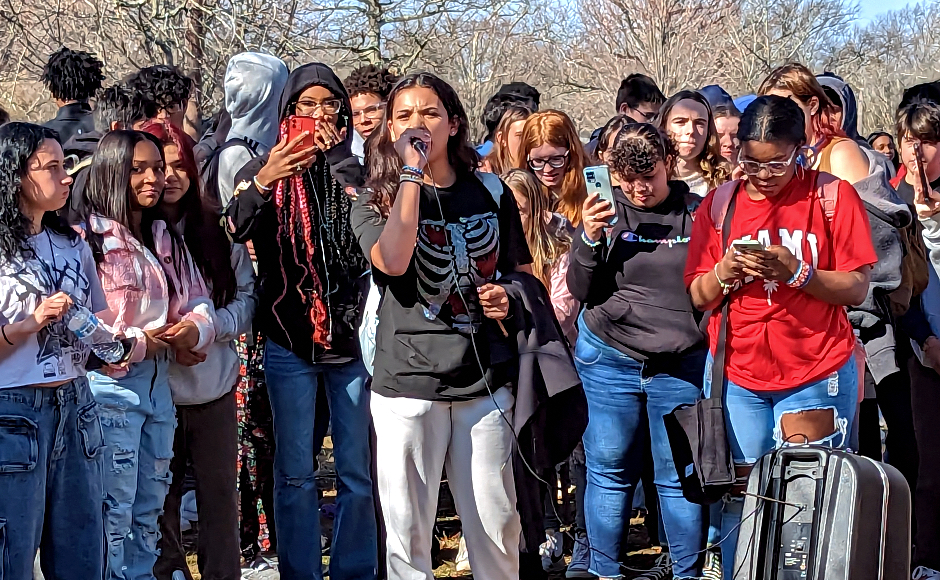
In 2023, Collingswood High School students alleged racial bias from teachers and staff in their building. Credit: Matt Skoufalos.
Despite Brown and her classmates reporting such behaviors to staff, she said little was done about it.
She said many students became so discouraged by the lack of a response that they just stopped speaking up for themselves.
“A lot of the students at the school, even if there is a literal hate crime committed to them, I think they’re too afraid to do anything about it,” she said.
Brown said that she mostly experienced racial taunts, epithets, and slurs from white, male students who “are not afraid to do it in your face.
“The girls still do it, but the boys do it in a public manner,” Brown said. “Since middle school, they’ve had multiple instances of being rude about people of color, people who are gay, people who come from different homes.
“They’re really not afraid to speak their mind about certain people who shouldn’t be there, or what they’re going to do [about it],” she said. “It’s just really weird to see, especially in this day and age.”
Whether such behaviors were born in group chats and parasocial Internet conversations, they have since crossed over to interpersonal interactions, Brown said. She believes that the boldness behind them has been inspired by a lack of consequences, either social or institutional, for such behavior.
“When it comes to bullying people, they don’t think they have to do it on the Internet anymore; they can just do it to your face,” Brown said, “[especially] when the students know that the most they’ll get is a 10-day suspension.”
Although Brown has not been on the CHS campus for the 2024 school year, another student who is currently enrolled at CHS agreed to speak about their experiences there on condition of anonymity.
They talked about encounters that manifested in high school, where the student populace is almost evenly split among white and minority students, but which began in their predominantly white Collingswood elementary school.
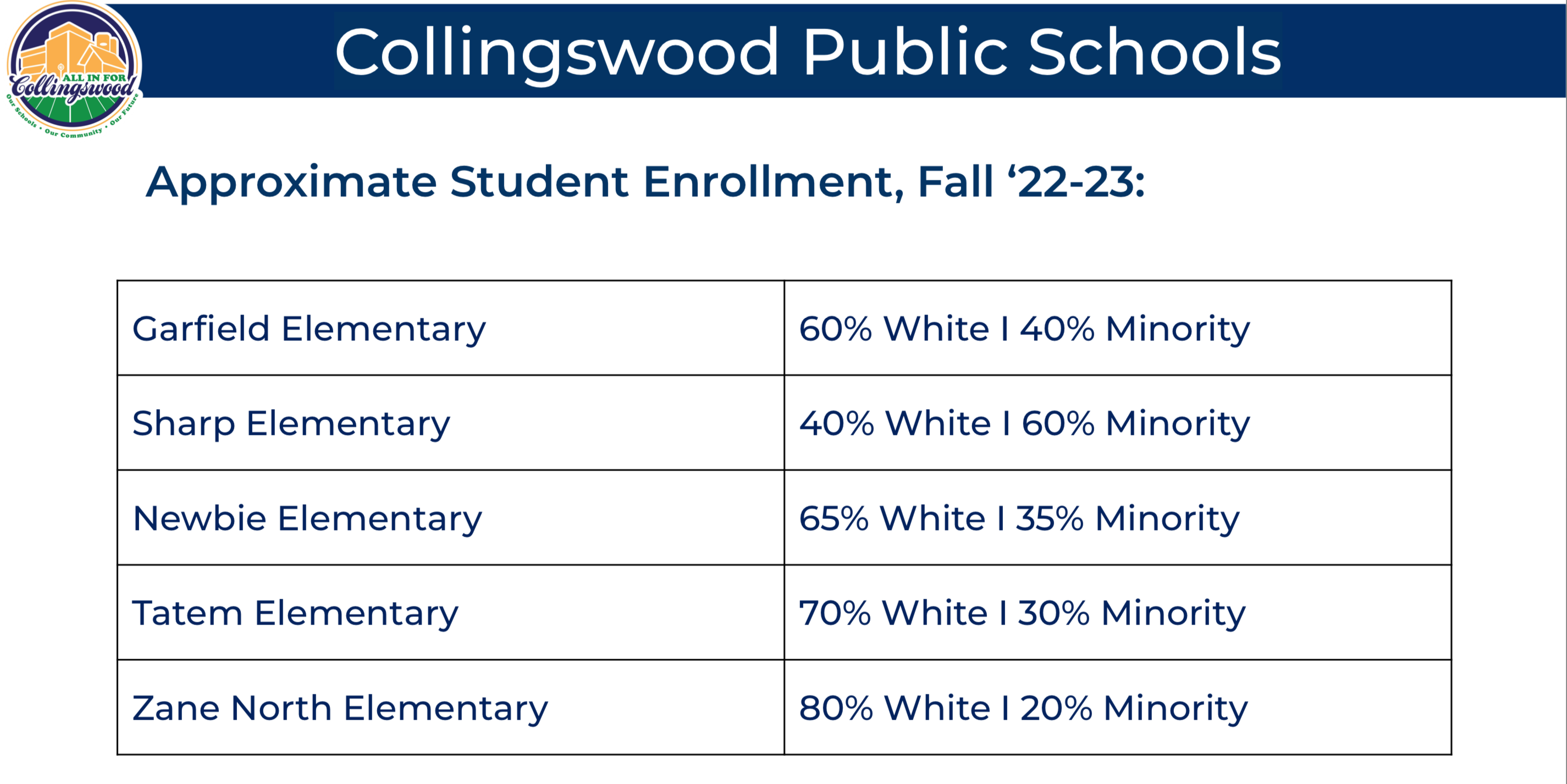
Collingswood elementary school demographics. Credit: Collingswood Public Schools 2024 Bond Referendum Presentation.
“Every single time we hang out in a big group of people, especially the guys, they will say some racist remark,” the student said. “My friends don’t speak up. I feel like they’re afraid of them.”
Much of the behavior the student identified began in a digital format, whether on group messaging chats, text threads, or other online media. From there, it spread to personal encounters in which white students “send memes of the N-word and constantly use it in their vocabulary,” the student said.
As the years have gone by, other encounters have become increasingly uncomfortable, even in social settings outside of school. The student described one party at which a white classmate “kept begging” them to sing along with a song that had racial slurs in the lyrics, justifying the request by asking, “Please say it so I don’t have to say it.”
“Why don’t you skip it?” the student retorted.
“It’s an everyday thing,” they said. “I feel like they have power over us when they use it, when really, they don’t. I feel like if you check them they lose all their power.”
Beyond speaking up for themselves — the student said they are not shy about calling out racist behavior in the moment — the cumulative effect of attending school in such an environment takes a toll. To survive, they frequently lean on code-switching in different social groups, with different consequences.
“I feel like I’m switching up my whole personality,” the student said. “My friends of color call me out on it; ‘You switch it so quickly.’ At this point, I’ve done it so much that it’s instinct. It just became like a defense mechanism.”
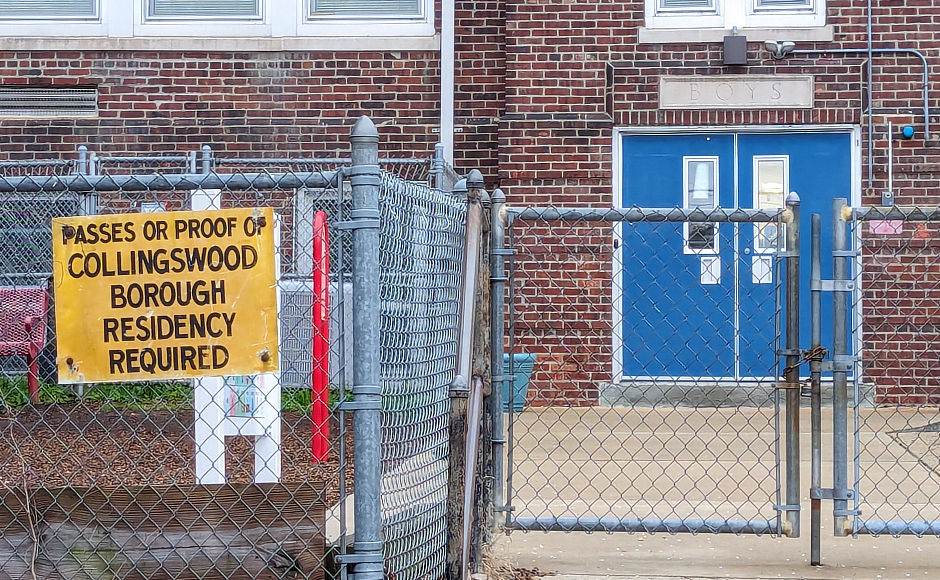
“Passes or Proof of Collingswood Boough Residency Required” reads a sign outside of Sharp School in Collingswood, the only majority-minority elementary school in the district. No other elementary school in the district has such a sign; district officials say it will be removed. Credit: Matt Skoufalos.
Within the CHS climate, teens are self-segregating socially by town of origin, the student said, because “they’re uncomfortable trying to mix in” among different racial groups.
Students from Woodlynne, which sends its high-schoolers to CHS, are discussed most negatively of all.
“Woodlynne’s not really in the picture,” the student said.
“They talk down about them; they say they all act very ghetto, very out of line, and that they’re the reason our school is not up to par anymore.”
Whiteness or Blackness is measured and discussed by degree of skin tone among CHS classmates, and most students feel obligated to align with one group or another, the student said. They are even held to different standards of beauty based on how white-acting or white-appearing they may present themselves.
“There were some days where I would just cry because I wanted to change myself,” they said. “Some of these things are still on my mind; to this day, I still compare myself.”
The only antidote to the behavior so far has been to call it out in the moment, the student said, while adding that most Black students — especially young women — do not typically feel empowered to do so in the present high-school climate.
“I haven’t gone to teachers because nothing’s going to be done, and you can’t report every single person,” the student said. “Last year I realized I don’t want to take this disrespect anymore. I’m not afraid of them, but they do need to be checked.
“It’s different for my friend,” the student said. “She’s mixed, and she’s still trying to figure out who she is. She says, ‘You can’t say that,’ but then when they say something back, she feels silenced.
“I feel like people in friend groups should start speaking up against it,” they said. “The only way it changes is people speaking up against it.”
Collingswood Board of Education President Regan Kaiden said that the district may need outside help to navigate the cultural issues that have built up in the borough over years.
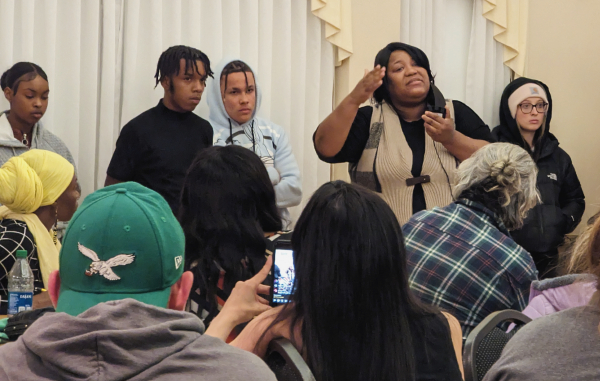
In February 2023, Collingswood parent Kaye (second from right) speaks about her family’s experience in the borough school district during a community meeting. Credit: Matt Skoufalos.
Although discussions in 2023 centered on CHS students’ reports of microaggressions from teachers, the issues on the table today are student-to-student, which, to her, bespeaks the scope of the work to be done.
“I think we’ve got a lot more work to do, and that it’s important for us as a board and a district to do things to tackle it more structurally,” Kaiden said.
“Long-term, that’s super-important, but that’s not meeting the needs of our students in the short term.
“What we haven’t been doing well enough, that we must do now, is provide a safe space for the students that are in our schools,” she said. “This is not something that I think our school district has the capacity to do on our own.
“These are big things, and if there is a time to look for help in dealing with some of these big issues, this is it,” Kaiden said. “We don’t currently have the staffing that would potentially make these affected students feel more comfortable or feel safe talking to those folks.
“If we need to bring in an outside organization that specializes in that kind of thing that can make things more comfortable for these kids, then that is what we need to do,” she said.
Those approaches must address multiple needs at once, the school board president said. Foremost, all students need to feel safe in their academic environment in order to be able to learn; secondly, those perpetrating racist behaviors need education and interventions to curtail those attitudes and actions.
“We need some serious healing as a full school,” Kaiden said. “There’s two parties to all of this, and at the end of the day, they’re all kids. We need to make sure that we’re actually serving all of them. We’ve all got to live in this world together, and that behavior is not okay.”
Kaiden also emphasized that moral instruction and behavioral correction are rooted in students’ home lives, which the school cannot influence as significantly. She emphasized “a real missed opportunity and missed important piece of the puzzle” if the work ahead does not involve outreach to families in the community.
“This is stuff that we’re hearing from high-school students that have that voice, but they’re talking about their experiences all the way down to elementary school, so we should be pretty comprehensive about how we’re tackling this.” Kaiden said.
“We’re not looking to pretend this isn’t happening,” she said. “The kids coming up again, almost exactly a year after the last time, are screaming to us to not just let this fester anymore, and we need to listen to it.”

